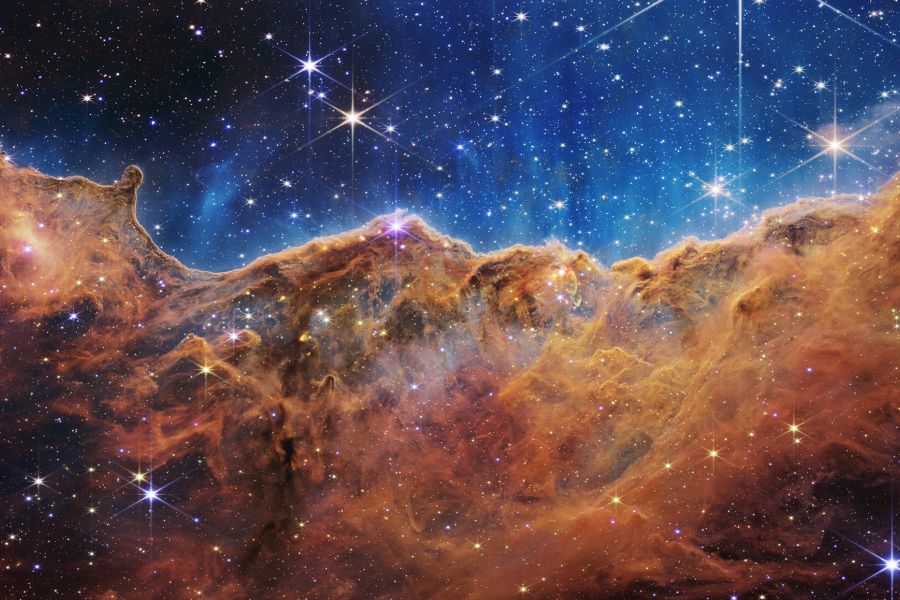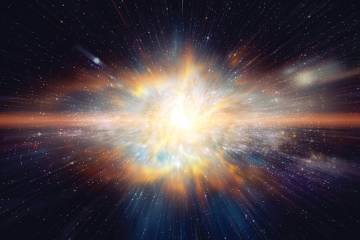If the hype weren't from NASA, you might think it hyperbole: "Never before seen images of the universe."
But an endeavor doesn't get any more cosmic than that of the $9.7 billion James Webb Space Telescope, which in December launched on a journey 1 million miles from Earth and today released its first batch of images from space. The full-color images show, in startling detail, corners of the unseen universe, from the star-speckled "mountains and valleys" of the young, star-forming region called NGC 3324, to the largest-ever mosaic of the millions of young stars in the galaxy cluster called Stephan's Quintet.
"There were times when we weren't sure if things would work, but they're working spectacularly," says Dan Coe, A&S '04 (MA), '07 (PhD), an astronomer with the Space Telescope Science Institute and instrument scientist on Webb. "It's just amazing. It's blowing my mind.
"We get these amazingly detailed images of distant galaxies and all these tiny little clumps and star clusters that just pop out that we could never see before," he adds. "And so, we're really seeing for the first time what galaxies looked like in the early universe."
NASA teamed up with the European Space Agency and the Canadian Space Agency on Webb, a mission that NASA administrator Bill Nelson says will "fundamentally alter our understanding of the universe." The space telescope, Hubble's successor, will be able to see back in time, capturing images such as the first galaxies that formed after the big bang, and will offer much-more-detailed views of nebulas and star systems in the distant universe.
President Joe Biden on July 11 released the first image from Webb, of galaxy cluster SMACS 0723, known as Webb's First Deep Field, as it appeared 4.6 billion years ago. The image covers a patch of sky approximately the size of a grain of sand held at arm's length by someone on the ground "and reveals thousands of galaxies in a tiny sliver of vast universe," according to NASA.
Today, July 12, NASA released several more images during a live broadcast.
"This is how the oxygen in our bodies was made—in stars, in galaxies," said Jane Rigby, Webb operations project scientist, in the telecast as she described an image of galaxies from more than 13 billion years ago.
Another image depicts an "extremely hot" exoplanet about the size of Jupiter located 1,000 light-years away, which has the "chemical fingerprint" of water vapor in its atmosphere, according to Knicole Colón, Webb deputy project scientist for exoplanet science. Future images from Webb will reveal more about planets in our own solar system, she says.
Space Telescope Science Institute scientist Stephanie LaMassa, A&S '08 (MA), '11 (PhD), a branch manager for Webb, describes the capture of these images as a remarkable achievement.
"Just the fact that this mission was decades in preparation and having a textbook-perfect launch. Just being involved in seeing all these different subsystems that need to work together—having 18 different individual mirror segments working as one—for all the instruments getting initial data and starting to process it and getting things working to the point where we could take these amazing images," she says. "It was a lot of work, people giving it their all for months on end."
First reactions to #JWST images in Schafler Auditorium ? pic.twitter.com/GSuazF9A1U
— Johns Hopkins Physics & Astronomy (@JHUPhysicsAstro) July 12, 2022
The Space Telescope Science Institute, located on Johns Hopkins' Homewood campus in Baltimore, is operated by the Association of Universities for Research in Astronomy. It led the science operations for Hubble and is now doing the science and missions operations for Webb.
"From a scientific perspective, there is something about humanity that just really wants to know about where we are and to where we came from," LaMassa says. "And what we're going to learn from JWST is definitely going to feed into that and give us probably more questions—it always does—but also give us some answers that I think will only increase our awe and appreciation of the universe."
Coe emphasizes that this is only the beginning of what Webb will yield.
"Every observation that Webb makes for the first year has the potential to transform our understanding of the universe," he says. "For many years to come, we're going to be doing so many exciting things. We're going to answer so many questions and then, of course, we're going to have more questions that we never dreamed of. I'm just so excited."









